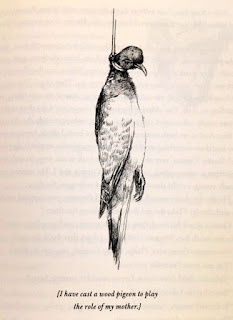Most likely, you've come across a Madame Tussaud's Wax Museum at some point in your travels. If you're like me, you were initially intrigued/impressed, but quickly began to view the wax sculptures as kitsch. But think back to the 18th century, a time before photography -- much less the internet -- existed. This is the world Edward Carey drops us into in "Little," his novelization of the life of the girl who became Madame Tussaud.
Truthfully, I didn't realize the book was about Madame Tussaud when I purchased it. It was Carey's wonderful (and sometimes gruesome) illustrations that led me to pick up his novel. I was all in from the preface, which promises "lost children, lost parents, ghosts of monkeys, tailor's dummies...the man who was shop dolls, his mother a mogul, the man who collected murderers...scenes of historical import...massacres of innocents, murders witnessed, bodies taken apart, blood on the streets, misery, prison, loss of everything, marriage, memories captured and contained, calamity daily exhibited, history owned." It's all in there -- and then some.
 |
"I have cast a wood pigeon to play the
role of my mother."
|
Sadly, the deaths that she witnessed were those of her parents. After her father died, young Marie (known as "Little" due to her diminuitive stature) and her mother headed to Berne to housekeep for Doctor Curtius. His home and occupation so freaked out Marie's mother that she hung herself.
What, you might ask, could be that dreadful? Curtius was fascinated with the human body. His atelier was overflowing with body parts. The fact they were made of wax did not assuage the horror Marie's mother felt. But to Marie, a new and exciting world had opened its doors.
 |
| Edmond, the widow's son |
"Something has happened," Curtius responds. "Something extraordinary. Just as the smaller radius bone is fused to the taller ulna, just as the fibula is to the tibia: we are connected. You and I....I shall not do without you." (Yes, this is a man who has a somewhat limited frame of reference.)
 |
| Former residents of the Monkey House |
But all businesses must evolve. Curtius lands upon the somewhat grisly idea of sculpting the heads of murderers. Keep in mind that in order to do this, the actual head must be obtained. Conveniently, the guillotine was the instrument of choice for putting criminals to death.
The widow, whose husband was a tailor, decides to put the wax heads on mannequins and costume them. The exhibit becomes so popular the group move to a much larger space (that happened to be the previous home of a bunch of monkeys). The precursor to Madame Tussaud's Wax Museum had come into existence.
 |
| The Royal Family enjoying a meal |
Frankly, I don't care how closely Carey's story aligns with history, as he's written an original, creative and thoroughly enjoyable book. But "Little" is more than a fun ride. It's the story of a girl who is called upon to muster her inner resources time and time again. While Marie may have been small in stature, she is large in heart, mind and commitment to survive and thrive. I couldn't recommend "Little" more highly.
For more about Tussaud and the book, click here to read an article Carey wrote for The Guardian about Tussaud and his work at one of her musuems.

.jpg)


No comments:
Post a Comment